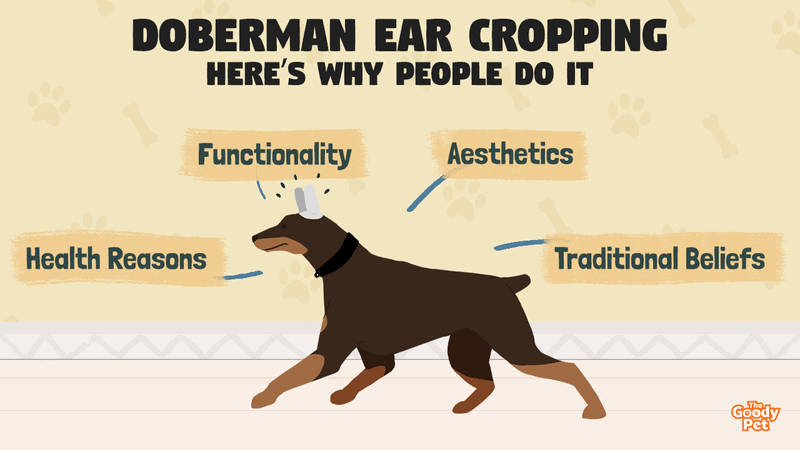Picture this: a grown Doberman with floppy ears! Sounds odd to you, right? That goes to tell you the prevalence of Doberman ear cropping in our canine community.
Ear cropping of Doberman Pinschers has been in practice for centuries, and the primary reason is to enhance the appearance of these dogs to look fierce. This practice describes the surgical procedure of cutting off the floppy ear parts of the Doberman to achieve the desired erect ears. Medical and functional reasons are also what many owners have given to justify this practice.
Some dog owners see ear cropping as a part of the canine culture for some breeds. If you share the same thought, there are several questions you need to ask yourself before trimming your furry friend’s ears. Is it cruel to do so? Are there valid reasons for you to make your dog undergo this surgical procedure? We’ll be answering these questions and several more shortly.
Why Do Dobermans Have Their Ears Cropped?
By convention, Doberman ear cropping is regarded as a prevailing practice due to several reasons. These reasons can include traditional beliefs, aesthetics, functionality, and health reasons.
Functionality
Dobermans are guard dogs by design. Picking up sounds with precision is one of the traits they need to function. As a result, some believe that floppy ears hinder this breed from picking up sounds as they should.
Meanwhile, there is the claim that floppy ears are an Achilles heel for dogs during a fight, as opponents can pull on them. Much larger dogs do not have erect ears and can hold their own against an attacker.
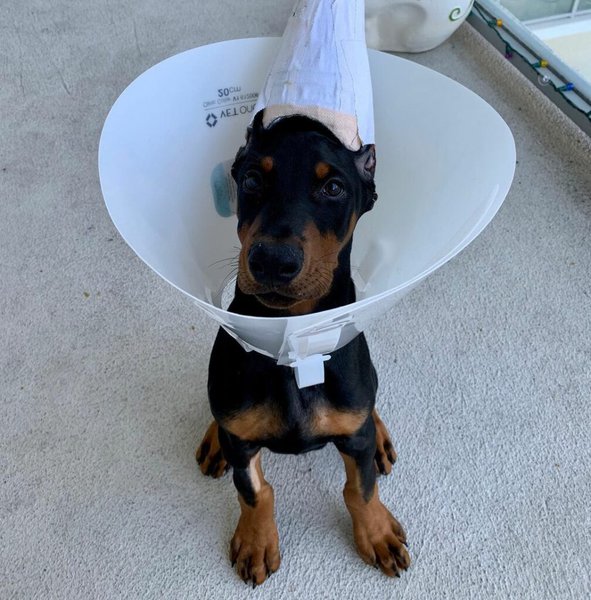
Traditional Beliefs
By convention, people have come to accept that Dobermans should have erect ears. It is even rare to find pictures of this dog breed with its broad and floppy ears.
More so, the widespread culture is that Doberman Pinschers should have pointed ears. You will find celebrities and adverts normalizing the trend. The American Kennel Club (AKC) ratifies ear cropping as well. Hence, floppy ears on a Doberman now appear like an aberration.
Aesthetics
Among the reasons people give to justify Doberman ear cropping, this is by far the most popular. Several owners of Dobermans do not find their floppy ears appealing, particularly as they increase in size. They have the desired appearance for each of their dogs.
Sadly, erect ears are what people deem to be the norm for all Dobermans. Many believe erect ears give Dobermans a fiercer and dog-fighting look, and owners opt for this cosmetic surgery to achieve it.
Health Reasons
There is an age-long belief that cropping a dog’s ears will prevent it from getting infections. People consider dogs with floppy ears to be more prone to ear infections and ear mites. Meanwhile, we recognize that droopy ears allow for moisture trapping and the breeding of bacteria. Some veterinary bodies agree with this too.
Can Doberman Ears Stand Up Without Cropping?
No, you can’t make Doberman’s ears stand upright without cropping. Although there are suggestions for taping the ears early enough, it doesn’t guarantee that the ears will be erect.
Several dog breeds have their ears naturally standing, but the Doberman Pinscher’s ears are congenitally broad and floppy. Besides, the cartilage of the ears is flexible and cannot naturally hold up the ears.
Cropping Your Dog’s Ears
Unless you are a licensed veterinary doctor, you must never attempt to crop your dog’s ears yourself.
Also, not every vet can crop your pet’s ears. It may surprise you to discover that American veterinary schools do not teach ear cropping. The same applies to most vet schools in Canada too.
By implication, vets perfect this cropping practice by learning on the job. Consequently, there is a high possibility of the procedure going wrong when you patronize an inexperienced veterinary doctor.
If you will not put your puppy at risk, you must also ensure that your vet has a license to practice in that state. Only vets with state licenses can do ear cropping. Ask to see their clearance to practice so that you don’t get into trouble.
The procedure may be external, but it can get complicated if the medical know-how is not there. An operation gone wrong can inflict unimaginable pain on the dog for the rest of its life. In several countries, it is against the law to attempt to do it yourself.
Therefore, you must consult a vet doctor to carry out the surgery. After cropping, your fido will take time to heal. We’ll discuss this in the next section.
Post-Surgery Recovery
Ear cropping generally takes between 4 to 8 months to heal completely. Although, the time will also vary based on the natural healing ability the dog possesses.
Meanwhile, there is a procedure to follow to ensure your canine recovers fully. Immediately after surgery, your four-legged friend will need between three to four days to get out from sedation. Loss of appetite isn’t uncommon at this time as well. There are also pain and antibiotics injections that you must give your pooch as recommended by the vet.
You’ll have to limit your Doberman from activities for the next two weeks or till the removal of sutures from the ears.
Doberman Ear Cropping Styles
All cropped ears do not look alike. There are three different cropping styles for Dobermans. These include:
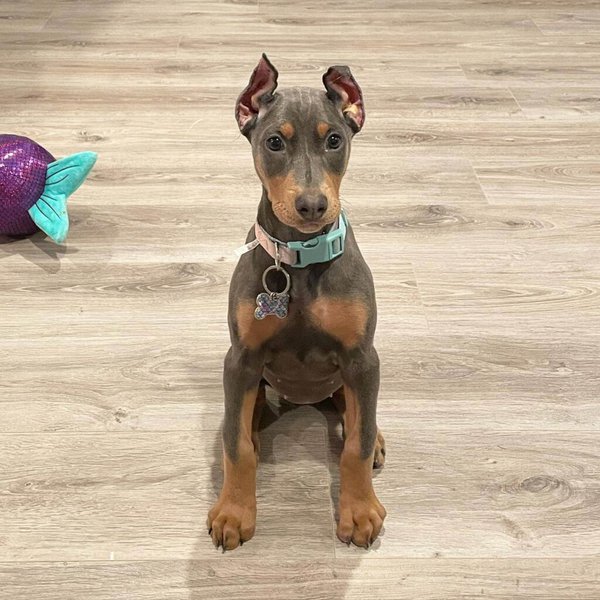
Military Crop
Also known as the working crop, the military style is the most common that you will find on non-show Dobermans. It happens to be the shortest of the three. You will notice the distinct broad base of the ears giving it a sharp triangular shape. This style is the easiest to maintain.
A variation of it will be even more stubby to provide the smallest area for grabbing during battle. You can term it the “battle crop.”
Show Crop
As it sounds, this is the one for Dobermans bred for shows. Another name for it is the eagle’s wings. Unsurprisingly, the Doberman’s ears are the longest with this cropping style. Ears also have a curved silhouette appeal.
The process of achieving this style is more demanding than the others. Sometimes, your Doberman may have to undergo multiple surgeries to achieve this cropping style.
Medium Crop
Picture the height of the ears to be the average of the other two types. Arriving at the style takes less time than the show cropping style. Notwithstanding, it will require considerable attention to get it done.
Is Cropping Doberman Ears Cruel?
Cropping Doberman’s ears is regarded as cruel by many anti-cropping proponents. Asides from the fact that it is an artificial adjustment on your four-legged friend, the ear-cropping process brings discomfort.
While many may argue that the pain will wear out with time, there is also the probability that your canine friend still feels pain several years after the cropping procedure. One such reason may be due to infections, such as gangrene and septicemia.
Moreover, there is a risk of growth occurring at the nerve cells and fibers of the scarred area. Should such a thing happen, your furry friend will have to live in pain unless corrected by another surgery.
The Argument Against Ear Cropping
Cropping Doberman’s ears is unacceptable because your canine friend risks having an ear infection apart from the tremendous pain they have to endure after the surgery.
Besides, there is no guarantee that the ears will stand erect even after surgery. Should the ears refuse to stand upright, it means the dog will bear the scars forever.
It is also no secret that one adorable way dogs express themselves is by using their ears. For example, when the ears are down and back, it is a sign of submissiveness. Ear cropping robs your furry friend of one of its means of expression. That’s as cruel as it comes.
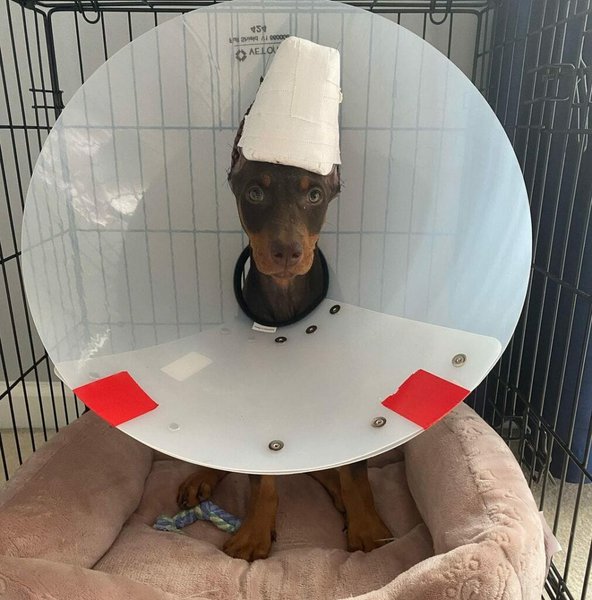
Should You Crop A Dog’s Ears?
One of the reasons you should not crop a dog’s ears is the pain they go through. After a surgical operation, the wound gets sore, and it can leave the dog traumatized in the long run.
Again, the dog has nothing to benefit from ear cropping. The pleasure of the outcome is for the owner only. Appreciating the organic look of your canine is a way to show you care.
More so, complications can occur from the use of anesthesia on your dog. Your dog may be allergic to it, causing it to go into anaphylactic shock, which can result in death.
Is Ear Cropping Painful?
Ear cropping is a painful process, especially after the sedative has worn out. The healing time can take between 4 to 8 weeks, and that’s a long time for your furry friend to be in pain.
Since owners are responsible for taking care of them after the procedure, there is every chance that canines will not receive proper care. That can lead to some infection in their ears, and the pain worsens. The implication is a longer healing time and a prolonged time of discomfort.
Besides, it is a known fact that dogs are sensitive to their ears. You can observe the canine brushing it against the wall and scratching at it for some reason. Cutting their ears will no doubt be traumatic when it comes to the feeling of pain.
Is Cropping Dog Ears Illegal?
Cropping a dog’s ears is illegal in many countries, while several others are indifferent about it. Some permit the cropping practice but restrict it to registered vet doctors.
For instance, the United States does not have a law against cropping a dog’s ears. Although a few states in the country have regulations against it, it remains to be seen if there will be a federal law prohibiting this act.
However, the AKC believes that dog ears cropping help preserve some character traits while enhancing the health of your furry canine. Meanwhile, the American Veterinary Medical Association’s policy frowns at the practice and calls for its outright ban.
Furthermore, the Australian Veterinary Association (AVA) clamors for putting an end to ear cropping and similar acts. The association refers to this practice as an operation for purely cosmetic purposes, hence unacceptable under any circumstances.
Seeing that different federations have varying inclinations to matters of ear cropping, it becomes necessary to adapt to the laws of where you reside. Also, as you move from one country to another, it is pertinent to get acquainted with their stance regarding the ear cropping of canines.
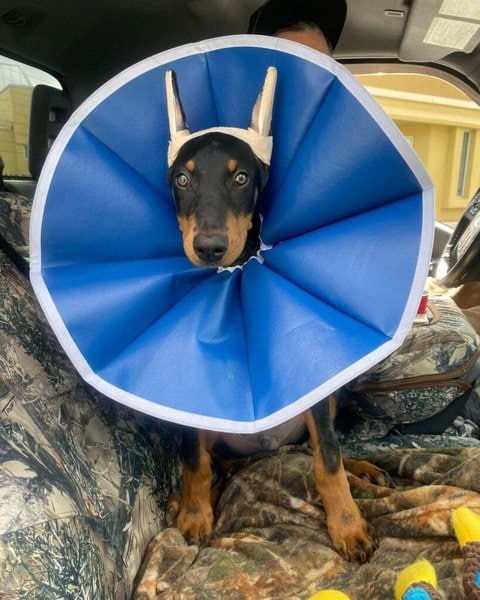
Where Is Ear Cropping Banned?
Ear cropping is punishable under the law in several nations. The sanctions can vary from fines to spending time in jail. In Europe, all countries aligned with the European Convention of 1987 for the Protection of Pet Animals prohibit dog ears cropping.
Among them are Germany and the United Kingdom. German law prohibits the exhibition of a dog with cropped ears at the World Dog Show either at home or abroad. In the United Kingdom, it is no different, and the local government has moved to stop the importation of dogs with cropped ears into the country.
Legal Status Of Ear Cropping In The United States
Till date, no state in the United States outlaws cropping of Doberman ears. Nine states regulate the practice of ear cropping in dogs, but none of them has an outright ban on the trend.
Connecticut, Maryland, New Hampshire, New York, and Pennsylvania restrict ear cropping to licensed vets. In other words, attempting to crop your Doberman’s ears by yourself is punishable. Meanwhile, the dog must be under anesthetics while carrying out the surgical process.
Maryland law also demands that the ear cropping must be appropriate to the animals concerned. For example, it is not appropriate to be cropping the ears of a Beagle, as the cropping practice on this dog breed is relatively unheard of.
Maine, Illinois, and Massachusetts have state laws in place to prohibit any procedure that will leave permanent damage to a body part in dogs. Consequently, only licensed vets can carry out the surgery.
Asides from the states above, it is culturally acceptable to cut your dog’s ears in every other area. However, you must not perform the procedure in a manner that comes under cruelty. Animal cruelty is noticably punishable under the Preventing Animal Cruelty and Torture Act (PACT) in every state of the United States.

